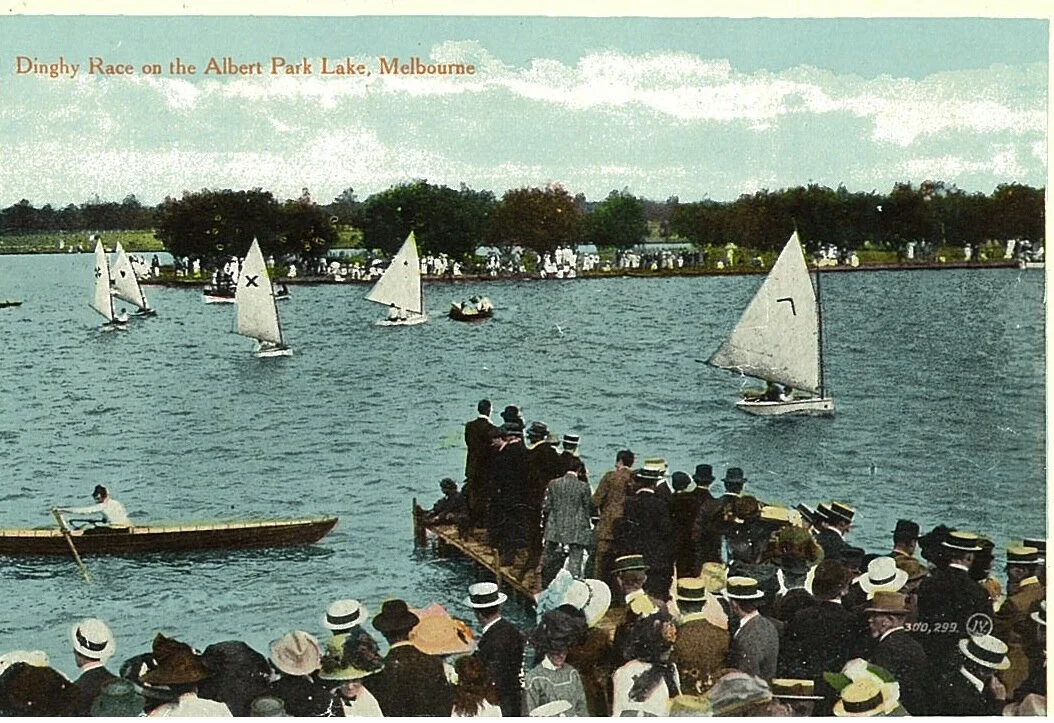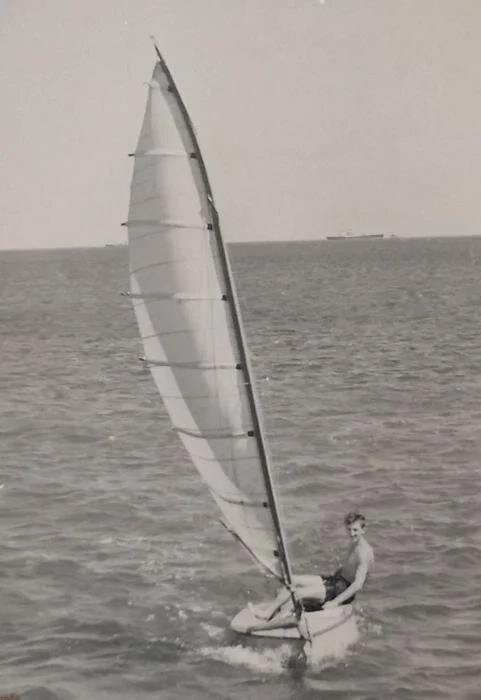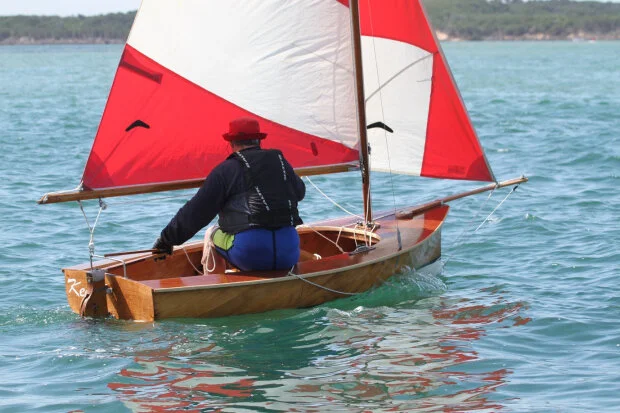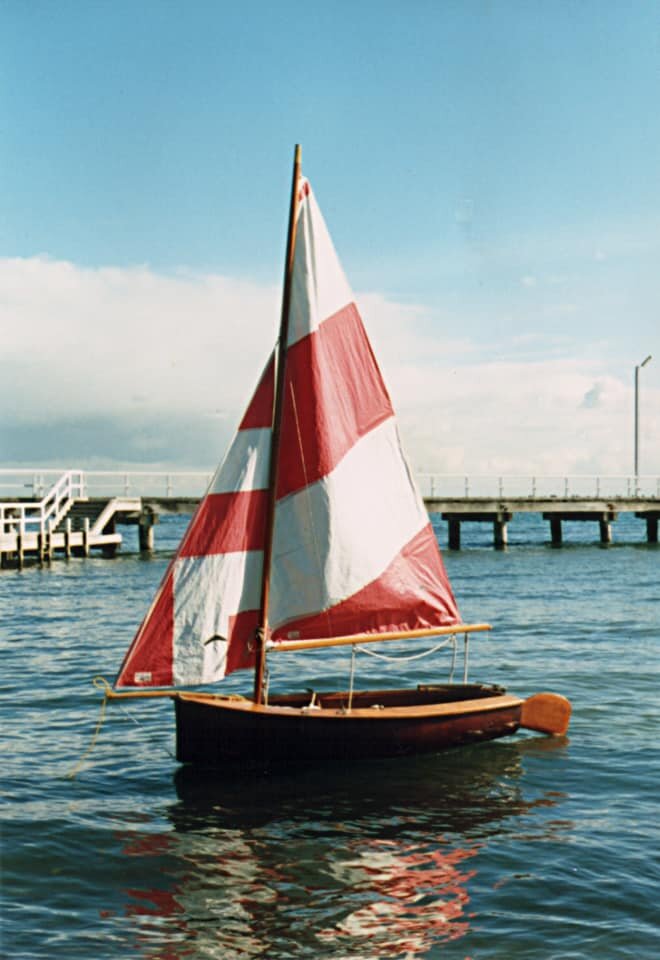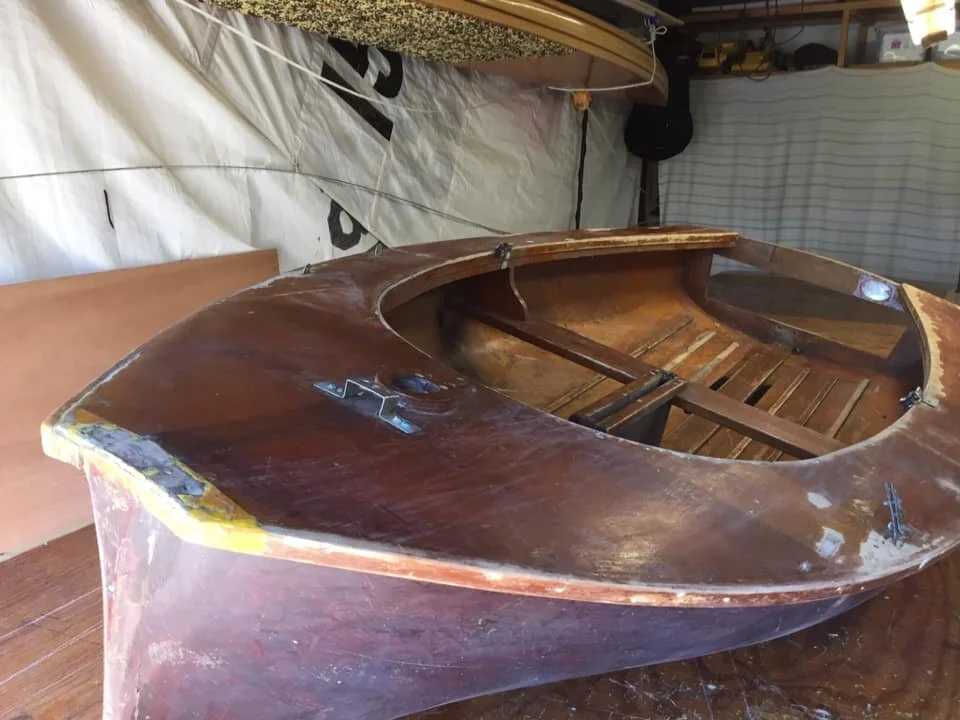Bail Sail or Swim
Victorian 8' Champion 1933
By the 1950’s, Sydney had developed small dinghies like the 6ft Balmain Bug and the Vaucluse Junior. Melbourne had the 8 footers and the Sabot BUT the ubiquitous Opti has conquered them all. SWS started thinking about how kids got a start in sailing in 1900. We’ll trace this story with the Albert Park and St Kilda 8 footers.
Some of these early boats were pretty unusual and difficult to sail but that’s how you sort out design and the kids who want to sail or swim. See a sailing 6’ Bug here
Three recent SWS stories had terrific reader response. MADNESS & MEMORIES - CHELSEA CLASSIC DINGHIES 25th March and REFLECTIONS & MIRRORS 6th and 20th May. We reported on the nostalgic revival of off-the-beach classes from the 1950’s and 60’s including some that allowed kids to learn to sail in a fit-for-purpose boat.
We’ll first look at two small Melbourne dinghies intended for juniors, the Albert Park and St Kilda 8 footers and the the clubs that supported them. We’ll follow with a story about the 7ft Tauranga “P”, a junior dinghy designed in New Zealand in the 1920’s. Finally, we’ll report on the ply revolution in the 1940’s & 50”s, a construction technique refined by wartime aircraft design that started the post-war dinghy boom.
For these stories, SWS would like to acknowledge the generous information shared by Mark Rimington of Gale & Rimington Sailmakers, John Fairfax of the Classic Dinghy Network and Chris Davey who is still in “draft” updating the Albert Park Yacht Club history for the sesquicentennial in 2022.
ALBERT PARK 8 footers
There were not many options for kids wanting to sail in the early 1900’s. Long before the introduction of lightweight ply and Dacron sail cloth, yachts were traditionally large, expensive to build and heavy to handle especially when things got wet. Hulls were framed and ribbed then clad with planks fixed with copper nails. Wooden masts carried Egyptian cotton sails with cane battens and cotton woven running rig. For speed yachts commonly added sail area and crew numbers for ballast. Small kids wanting to sail, often started in the bilge as bailer-boys only graduating to the gunwale when stronger and heavier.
8' Race Albert Park Lake 1913
Albert Park Yacht Club has been sailing on the lake since 1872 with a clubhouse built in 1880. From the 1890’s, boats were typically 18’ with gaff or top sail rigs carrying 270sq ft of sail and crews of five or more. By 1900 inter-club lake regattas between APYC, Ballaarat YC and Colac YC became regular events. See LAKE SAILING with IMMERSED BLADE SWS 22nd April. A few senior sailors saw an opportunity to introduce kids to recreational sailing. Chris Davey of APYC writes;
“In 1910 five boys spent a lot of time sailing model boats from one side of the Lake to the other. Edwin McRitchie, Past Commodore of APYC, took an interest in them and called a meeting to form the Albert Park Model Dinghy Club. It soon had twenty-five members, all sailing two-foot model yachts.
In a year they had all grown and McRitchie suggested the club should think about boats they could sail in. He had in mind an 8 foot one-design class. A design was drawn up and soon the NELLIE had been launched and other boats were being built. June 1911 saw the first Opening Day of the Albert Park Boys’ Dinghy Club. The dinghies were 8ft long, 4 ft beam with sail area of 72sq ft. They had a steel centre plate and a gaff rigged sail. Each boat had a prominent emblem on the sail, usually connected with the boat name and the boys wore white jumpers with the same emblem”.
The sail emblems show boats with classic names like KINGFISHER, KOOKABURRA, THISTLE, SHAMROCK, FLYING FISH and SWAZZIE (Swastika). From the photos very young sailors are two-up in the 1912 Opening Day Parade of Sail, but when racing, the 8’s were sailed one-up. The regattas on Australian Natives Association Day in January (ANA Weekend) and Easter were well attended. The photos show well dressed spectators on the western promenade, APYC club jetty and Pagoda Island (now a bird sanctuary). Albert Park Boys Dinghy Club would join the seniors on trips to Lake Wendouree and Lake Colac. The line-up of 8’s on Lake Wendouree in the 1920’s shows skippers of all ages. The health of this class across various Victorian clubs allowed an 8 Foot Dinghy Championship, recorded until 1935.
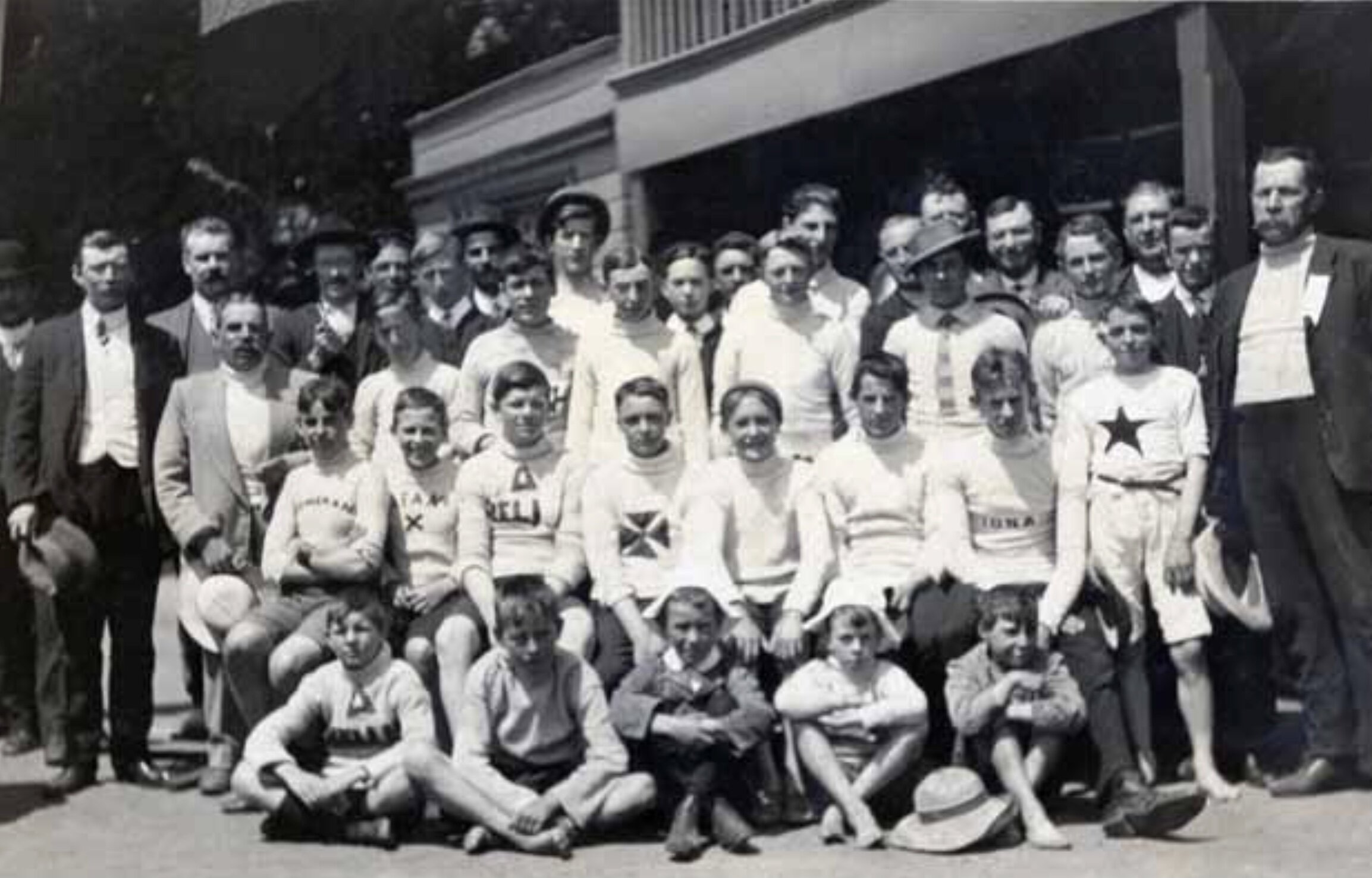
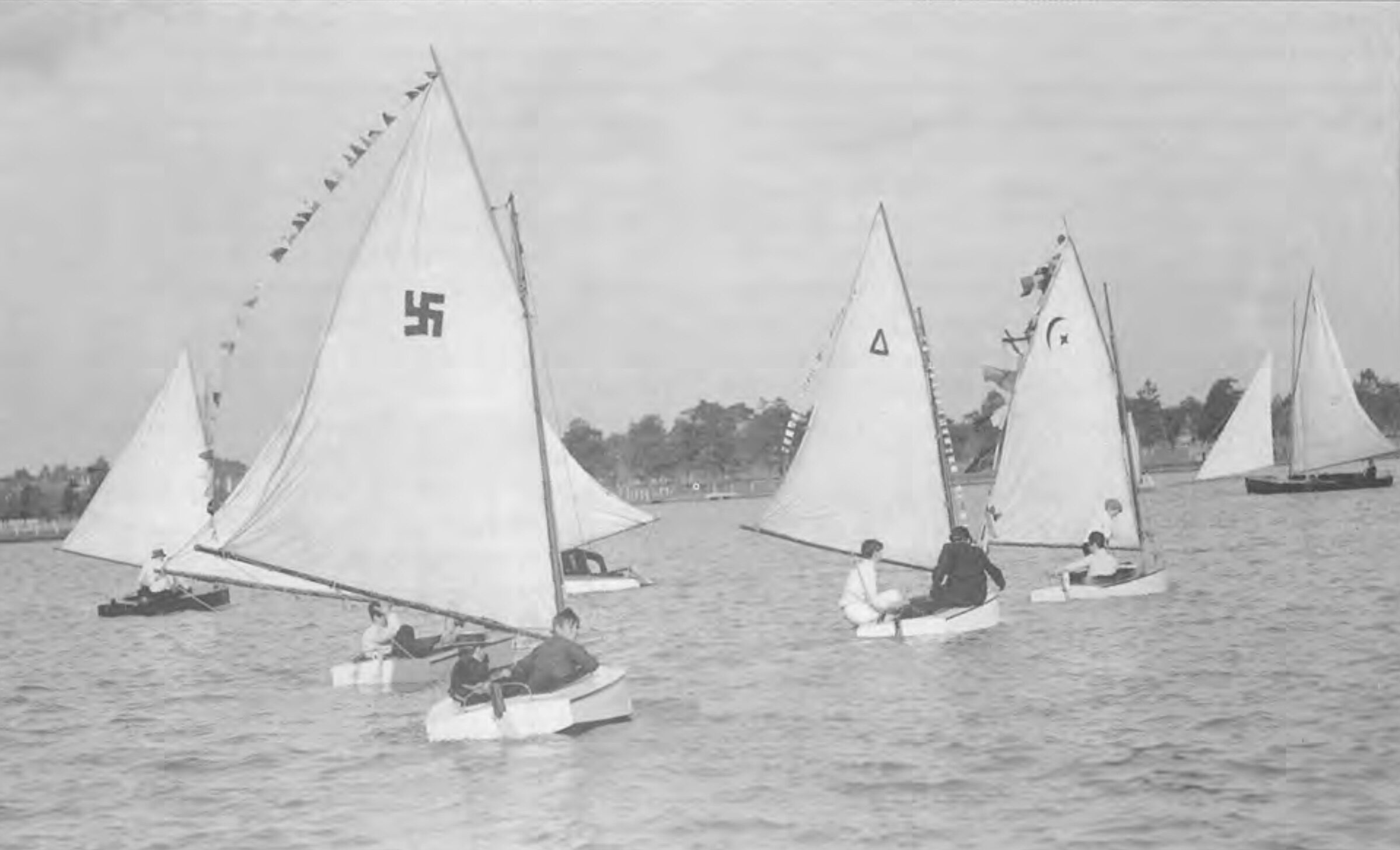
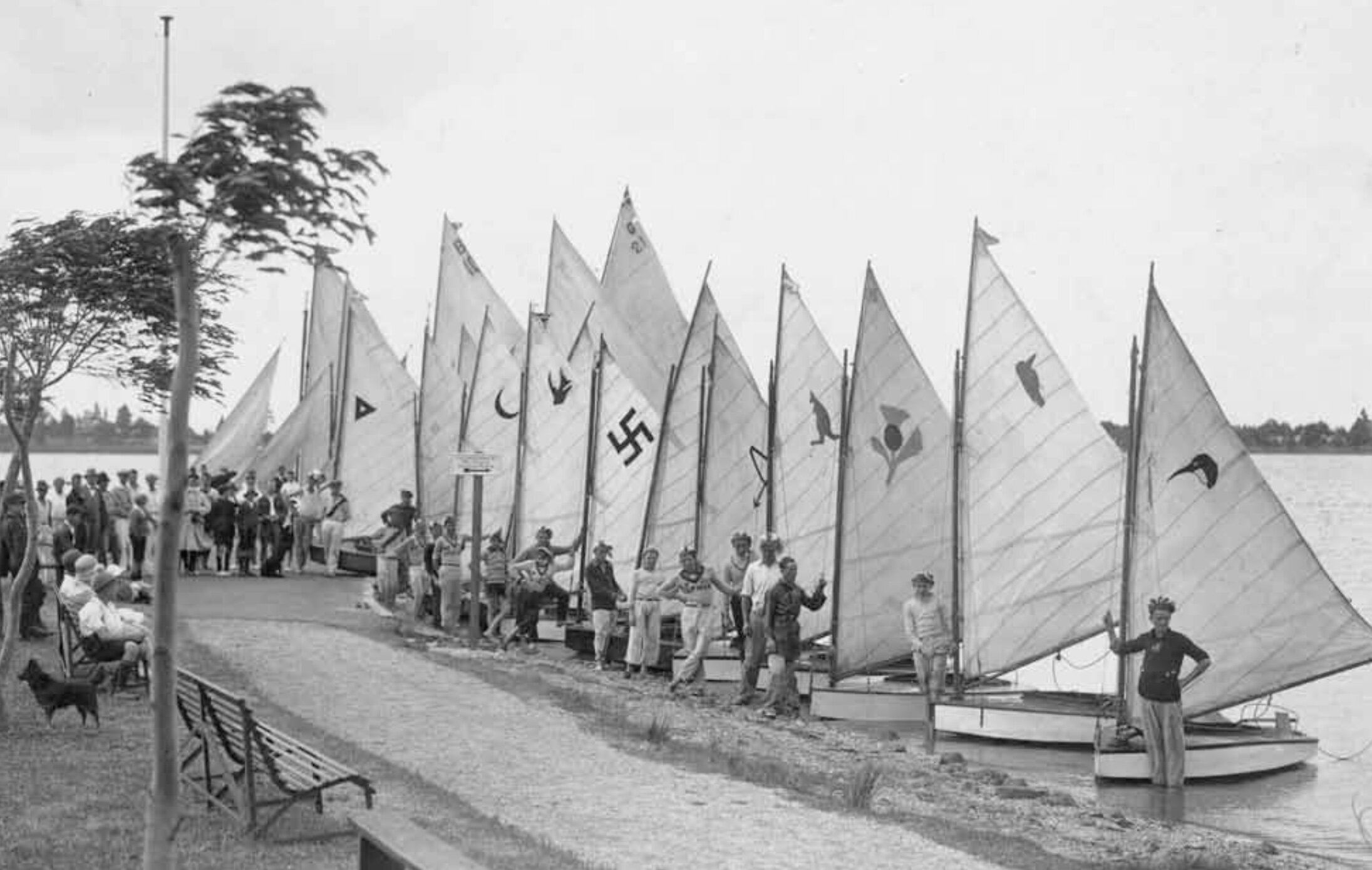
It’s worth stepping out 8 feet (2.4m) on your floor to understand just how small this is. These early boats were traditionally built with a flat bottom hard chine hull, no built-in buoyancy and weighing some 150lb. The forward stepped cat rig and extended boom carrying 70sq ft of cotton cloth without a vang, could not have been easy to sail. The shroud position meant reaching and tacking downwind rather than square running which was probably a safer bet anyway. The large sail area was likely needed to offset the weight. On the Lakes these boats were safe to sail in a light breeze with little chop. While intended as a junior dinghy, more experienced teenage skippers were more successful at handling this twitchy boat in a good breeze. C. G. Le Gassick, the Victorian champion in 1933 certainly looks a bit older. See the 8 footers racing on Albert Park Lake in 1931.
We have no drawings or information about the designer. Even as a one-design class, there was a natural bit of dimensional slippage between boats and clubs over the years. The Ballarat Yacht Club History notes their 8 ft boats having;
“a mast mounted perilously close to the bow, maximum length 8’ 6”, beam 4’ and 80sq ft of sail. They competed until late 1940’s with names like TYPHOON and JOLLY ROGER with sail insignia rather than sail numbers until replaced by early Moths”.
The Albert Park 8 footers lasted for 40 years until the war when many things were changing for all Lake boats. Chris Davey writes;
“By 1938 most Lake races were being won by the Australian version of the Snipe. It seemed that the day of big yachts was over. Sharpies and Moths also joined the fleet. If sailing was to continue it would be in smaller one or two-man boats, possibly home-built, using new glues and marine plywood which was becoming available in Australia after its invention in 1935. These materials revolutionised the sport of small boat sailing”
ST KILDA 8 Footers
When these designs developed as St Kilda 8 footers, tackling the unpredictable conditions on Port Phillip Bay was a challenging proposition. There’s no sure lineage but this little boat is clearly a variation of the Albert Park 8ft dinghy. The story can be followed in John Fairfax’s notes and Robb Legg’s personal recollections on the Classic Dinghy Network website. John Fairfax writes:
“The St Kilda 8 ft was the junior class of the St. Kilda 14 Foot Sailing Club. It evolved from the Albert Park 8 footers and was not related to the much earlier 8ft Skiffs that sailed on Sydney Harbour at the end of the 19th century (see SHE SAILED SWS 24 June). Later versions had a round-bilged hull, were cat-rigged and carried a single sail of 70sq ft on a 17ft. mast. It had a small bowsprit which gave the forestay a better angle to support the mast.
Early hulls built just after the war were built out of planks and weighed around 150 pounds. In the early 1950’s both the 14 footers and the 8 footers started using the newly available waterproof ply reducing the hull weight by half. Later boats had a more flattened aft section, a finer bow and fewer frames reducing the hull weight even further. The first plywood hulls had a 2” x 1” frame every foot because it was thought that the plywood was so thin and flimsy it would fall apart”.
KEELEY & LEGG
Brooks Jetty & Luna Park’s Scenic Railway at St Kilda with 14ft Dinghies after WW2
Bob Keeley and Rob Legg were the sailors behind the famous Melbourne eponymous company. From their teenage years, they were great sailors with Bob Keeley working as a sailmaker and Rob Legg a boatbuilder who developed vacuum ply construction at Mouldcraft in Frankston. Rob’s story is a classic introduction to junior sailing and a commitment to a life in the industry during the transition from traditional boatbuilding to volume built ply dinghies.
Rob Legg grew up in Doncaster and was just out of school aged 15 in 1944 when his parents moved to a mixed business in Hoddle St Collingwood. After landing a decent job, he often rented Hooper boats on Albert Park Lake and taught himself to sail on weekends. RL writes;
“Now with a bit of cash to spare I could at last afford to join a sailing club, and that was something I had been longing to do for a long time. Hanging around the St Kilda 14 footer club on a Saturday and hoping to be picked as a bailer boy when the weather was rough was fine, but I wanted badly to belong and sail every Saturday in a permanent crew.
There was a boat in the club called TROJEN, owned by Bob Keeley. He asked if I cared to join his crew (would I ever), and so it came about that I became the main sheet hand. On moderate days we sailed with four in the crew, but when it was blowing we picked another as bailer boy. The 14 foot club had a junior class, it was eight feet long, cat rigged and carried 70sq feet of sail. These boats sailed on Sunday morning, so if I built one, I could sail on Saturday and Sunday”.
RL bought the plans from the club and built the boat in his parent’s tiny inner city back yard. He remembers the specification notes;
“Half inch Maple or Silver Ash planking, a half inch planked deck and a 2” x 1” frame every foot. Fastenings were copper nails and roves and all timber surfaces should be coated with red lead before assembly. The finished boat weighed around 150lb and was quite a lift for two men”.
Rob Legg sailing his second 8 footer at St Kilda. RL Archive.
Rob sailed this boat for a year before building his second 8 footer from newly available marine ply. RL continues;
“In 1946 when I was 17 years old, I built a second 8 footer in Collingwood and the curved mast upstairs in the hallway. Bob Keeley and I made our own sails and were experimenting with full battens which had not existed before. The curved masts were experimental, trying to control the twist in the sails as boom vangs had not been thought of then”.
Taking his cue from the 14’s, Rob was already refining his 8 foot set-up while halving the weight. He still carried the 70sq ft sail on his “walking stick” mast continuing with a small bowsprit to improve the angle of the forestay. It’s unclear if this was a single mast or a gunter rig? Regardless, this set-up working into a Port Phillip southerly with the slop off St Kilda beach would have made Rob Legg’s dinghy very lively to sail. Returning to shore downwind without a vang was quite a challenge. Only a skilled sailor like Legg could have handled the boat. The vang is credited to Paul Elvstrom introduced some years later.
st kilda 14ft sailing club on the Lower Esplanade
St Kilda beach was a popular playground for Melbourne and the 14 Foot Sailing Club played an important role in developing young sailors. 14 footers were and still are a very competitive development class from the early 1900’s. The boat just needed to fit between 2 posts 14 foot apart while the sail area was unlimited. The club was on the beach at Brooks Jetty opposite the Scenic Railway at Luna Park. By the 1940’s, the club was active and well supported, encouraging kids of all ages to join and learn to sail. Their ambition was on show on the St Kilda beachfront when the club added a beautiful Art Deco “speed style façade” over the old Brooks boat shed (sadly destroyed in a storm in the early 1960’s). Sail training, boat building courses and social activities were developed to keep the young crews together during the winter season. The 14 Foot Club also had an ice hockey team, the Pirates, who played competition at the St Moritz rink a short walk to the Upper Esplanade. Lindsay Fox, a local trucking magnate was on the team and Noel Brooke started with the Pirates before becoming a skilled sailor and sailmaker.
The Pirates. St Kilda 14 foot Sailing Club Ice Hockey team 1949
There were three versions of the St Kilda 8. Firstly the traditionally built heavy hulled cat rigged gaff, like the Albert Park 8 footer. Then in 14 foot experimental mode, Rob Legg started to refine the shape with his second lighter ply boat adding a bendy mast while keeping the 70sq ft fully battened sail. These changes somewhat backfired as Legg’s well intended developments had made the boat almost un-sailable except by experienced guns and certainly not by juniors. An apocryphal story at the club had the Finn sailors from the 1956 Olympics trying the 8’s and even they couldn’t handle them.
To re-boot the 8 as a junior boat, a decision was made to revise the rig in the 1950’s. This third version had the mast stepped further aft and shortened, a jib was carried from the bowsprit and the sail area reduced from 70 to 50sq ft. Even a small spinnaker was an option. These hulls were built with moulded ply by Legg’s company. By now the St Kilda 8 was in competition with easier to manage junior classes like the Sabot which became popular in the neighbouring bayside clubs at Beaumaris and Black Rock. The 8’s eventually disappeared around 1960 along with the St Kilda 14 Foot Sailing Club building and the club itself was amalgamated with the Royal St Kilda Yacht Club (now Royal Melbourne Yacht Squadron).
Mark Rimington sailing KEITH
ST KILDA 8 OLYMPIAN
It’s quite hard to find sailors who knew or sailed these small boats. However SWS recently met Bill Hodder. Bill first sailed a “P” class on Albert Park Lake then ordered a St Kilda 8 from Keeley & Legg in 1954. Legg made the hull at Mouldcraft in Frankston and Keeley made the rig and sails in Brighton. On delivery Bill recalls carrying the boat with his father across Nepean Highway to Dendy Park where Keeley showed him how to set-up. Bill quickly became a skilful helm sailing his 8 footer at Sorrento from Shelley Beach where the weather and tide can really push through from the Rip. As a young man in the late 1960’s, Bill travelled with a Finn behind his car to sail train at European regattas. On returning to Melbourne, he was runner-up in the 1971 Finn Olympic trials to John Bertrand who gained a 4th at Munich 1972. With family commitments, Bill often regretted not going to Munich as the selected emergency, so he made a come-back 20 years later to be the Soling representative in Barcelona 1992.
KEITH & MARK
The only extant St Kilda 8 in Melbourne is KEITH. Mark Rimington discovered the Mouldcraft shell and she is now beautifully restored and named for the previous owner Keith Higgins. Mark sails her in the classic dinghy regattas while promising to return to the 70sq ft rig. We’ll finish on a “Figure of 8” stopper knot by mentioning that Mark did his sailmaking apprenticeship with Bob Keeley before joining North Sails. With his sailing partner Peter Gale they started their own loft and were Flying Fifteen World Champions in Napier NZ 1982. His experience is still very much in demand.
St Kilda 8 KEITH from the stern
St Kilda 8 KEITH restored
KEITH pre Restoration
Photo Credits: Chris Davey APYC Archive. State Library Victoria. John Fairfax Classic Dinghy Network. Mark Rimington


